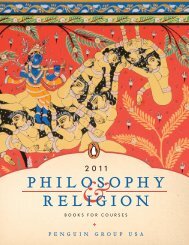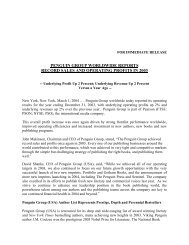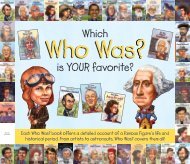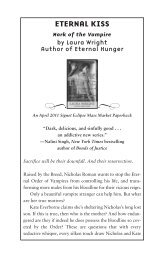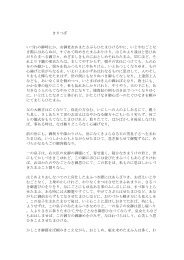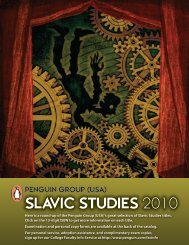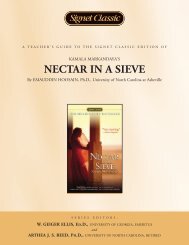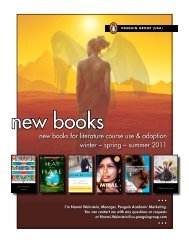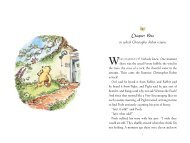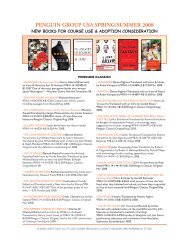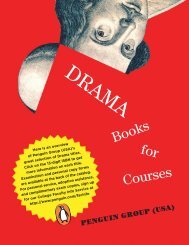Twelfth Night TG - Penguin Group
Twelfth Night TG - Penguin Group
Twelfth Night TG - Penguin Group
You also want an ePaper? Increase the reach of your titles
YUMPU automatically turns print PDFs into web optimized ePapers that Google loves.
A Teacher’s Guide to the Signet Classic Edition of William Shakespeare’s <strong>Twelfth</strong> <strong>Night</strong> 9<br />
10. There are several scenes in the play that are crucial to understanding and appreciation:<br />
Act I, scene iv — Viola revels that she, pretending to be a he, has fallen in love with Duke Orsino.<br />
Act I, scene v — Countess Olivia reveals that she has fallen in love with Cesario, really Viola.<br />
Act II, scene iii — The conspirators plan revenge on Malvolio after he reprimands them.<br />
Act II, scene v — Malvolio finds the forged letter and is taken in by it.<br />
Act III, scene iv — Malvolio makes a fool of himself before Olivia; Sir Andrew starts his duel; and Viola/Cesario,<br />
seen as Sebastian, refuses to return money to the sea captain, thus giving Viola hope that her brother lives.<br />
Act IV, scene iii — Olivia marries Sebastian, thinking he is Cesario/Viola<br />
Act V — The deceptions are discovered and the plot resolved.<br />
Students can identify the scenes they think are crucial and discuss why and what would have happened if that scene had<br />
never taken place. Since there are no “right” answers, the discussion can, at any time, be left on hold until the end of the<br />
play and then re-visited.<br />
AFTER READING THE PLAY<br />
Once students have finished reading, acting, and discussing the play to its concluding scene, they can look back at what<br />
has happened, as they might when leaving a movie theater. In some cases, a “So what did you think?” may be enough.<br />
The following activities, however, are designed to help them think about characters and plot, and especially comedy and<br />
romantic love.<br />
1. This guide has given an act-by-act, scene-by-scene overview of the play. With all the complexities of plot and character,<br />
summarizing <strong>Twelfth</strong> <strong>Night</strong> isn’t easy. Students can pretend that they’ve just seen it as a TV program or movie and a friend<br />
asks, “What was it about?” They can write what they would say — record it — without using acts and scenes since movies<br />
and TV rarely resort to such divisions. Then they can exchange papers with another student, each student trying to play<br />
the role of the friend who made the mistake of asking, “What’s it about?”<br />
2. Many people in the play are in love with almost none of that love being returned until the end of the play. Students can<br />
look back at each of those relationships and ask:<br />
• Was he really in love with her or did he just think he was?<br />
• How did he feel when he learned that she didn’t love him?<br />
• How did she feel knowing he loved her but she didn’t love him? And especially when she loved someone else who<br />
didn’t love her?<br />
(To keep the questions as simple as possible, the guide uses only one pronoun where “he/she” fits most of the references<br />
in the questions. Some of these questions will apply to more than one character and not all will apply to every character.<br />
Answering them, however, does force students to consider — perhaps reconsider — the different aspects of romantic love<br />
displayed in the play.)<br />
3. Since the approach suggested in this guide is to treat the play as an Elizabethan TV comedy, students can reflect on the various<br />
events of the play and create a plan to present it in a year or less as a TV series. What would the fall premier be? Would it<br />
start the way Shakespeare started his play? What would happen in each half-hour episode? What would the season finale be?<br />
4. Students can look back at the TV series and movies they considered before reading the play and look for ways that <strong>Twelfth</strong> <strong>Night</strong><br />
resembles one or more than one. They previously considered what makes a TV episode funny; now they can use the results<br />
of that consideration when discussing what makes <strong>Twelfth</strong> <strong>Night</strong> funny or at least, what funny elements are included.<br />
5. Working from a list of the significant characters, students can select the one they would like to play in a production of<br />
<strong>Twelfth</strong> <strong>Night</strong> and explain why by referring to events involving the character and the words the character speaks. As an<br />
alternative, they might choose the character they wouldn’t want to have to play.<br />
6. Students can vote for the silliest, wisest, meanest, and most likable character in the play (much like class yearbooks have Class<br />
Clown, Cutest Couple, etc.) and then discuss why they selected each, referring to specific actions and dialogue of the characters.




